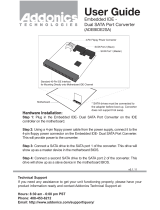
33
33
3
ContentsContents
ContentsContents
Contents
1.1.
1.1.
1.
IntroductionIntroduction
IntroductionIntroduction
Introduction
......................................................................................................................
......................................................................................................................
...........................................................
5 5
5 5
5
1.1 Package Contents ..................................................................... 5
1.2 Specifications ........................................................................... 6
1.3 Minimum Hardware Requirement Table for Windows
®
Vista
TM
Premium 2007 and Basic Logo .................................................. 9
1.4 Motherboard Layout ................................................................... 10
1.5 ASRock DVI/H I/O ..................................................................... 11
2.2.
2.2.
2.
InstallationInstallation
InstallationInstallation
Installation
..........................................................................................................................
..........................................................................................................................
.............................................................
12 12
12 12
12
Pre-installation Precautions ................................................................ 12
2.1 CPU Installation ......................................................................... 13
2.2 Installation of CPU Fan and Heatsink ......................................... 13
2.3 Installation of Memory Modules (DIMM) .................................... 14
2.4 Expansion Slots (PCI and PCI Express Slots) .................................. 16
2.5 Dual Monitor and Surround Display Features ............................. 17
2.6 HDMI Audio Function Operation Guide ...................................... 20
2.7 Jumpers Setup .......................................................................... 21
2.8 Onboard Headers and Connectors ............................................. 22
2.9 SATAII Hard Disk Setup Guide ................................................... 26
2.10 Serial ATA (SATA) / Serial ATAII (SATAII) Hard Disks
Installation ................................................................................. 27
2.11 Hot Plug and Hot Swap Functions for SATA / SATAII HDDs ....... 27
2.12 SATA / SATAII HDD Hot Plug Feature and Operation Guide ....... 28
2.13 Driver Installation Guide ............................................................. 30
2.14 Installing Windows
®
2000 / XP / XP 64-bit / Vista
TM
/
Vista
TM
64-bit Without RAID Functions ...................................... 30
2.14.1 Installing Windows
®
2000 / XP / XP 64-bit Without RAID
Functions ...................................................................... 30
2.14.2 Installing Windows
®
Vista
TM
/ Vista
TM
64-bit Without RAID
Functions ...................................................................... 32
2.15 Installing Windows
®
2000 / XP / XP 64-bit / Vista
TM
/
Vista
TM
64-bit With RAID Functions ........................................... 32
2.15.1 Installing Windows
®
2000 / XP / XP 64-bit With RAID
Functions ...................................................................... 33
2.15.2 Installing Windows
®
Vista
TM
/ Vista
TM
64-bit With RAID
Functions ...................................................................... 34
2.16 Untied Overclocking Technology ................................................ 34




















